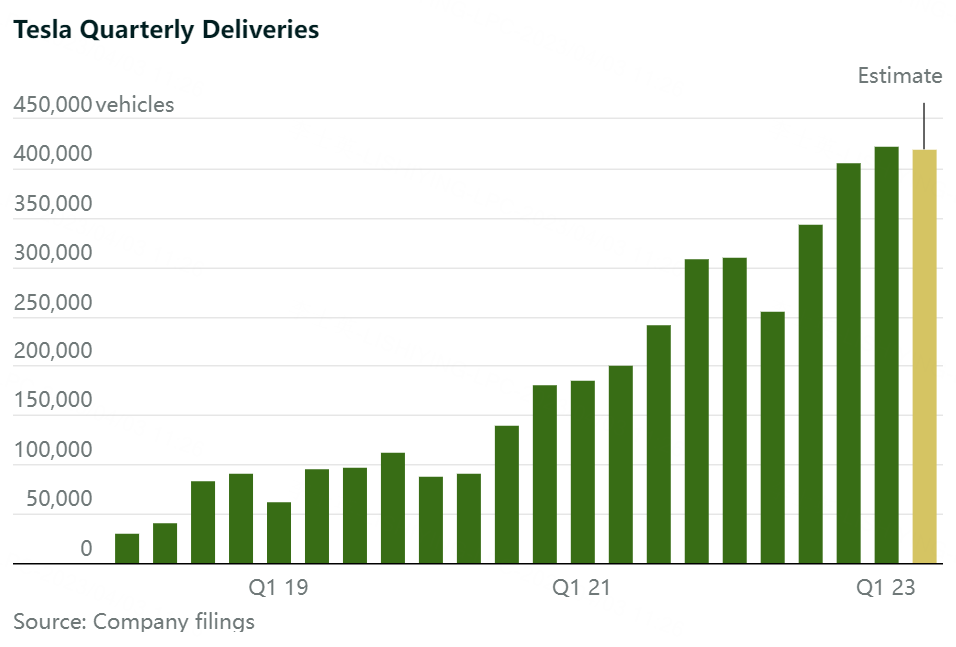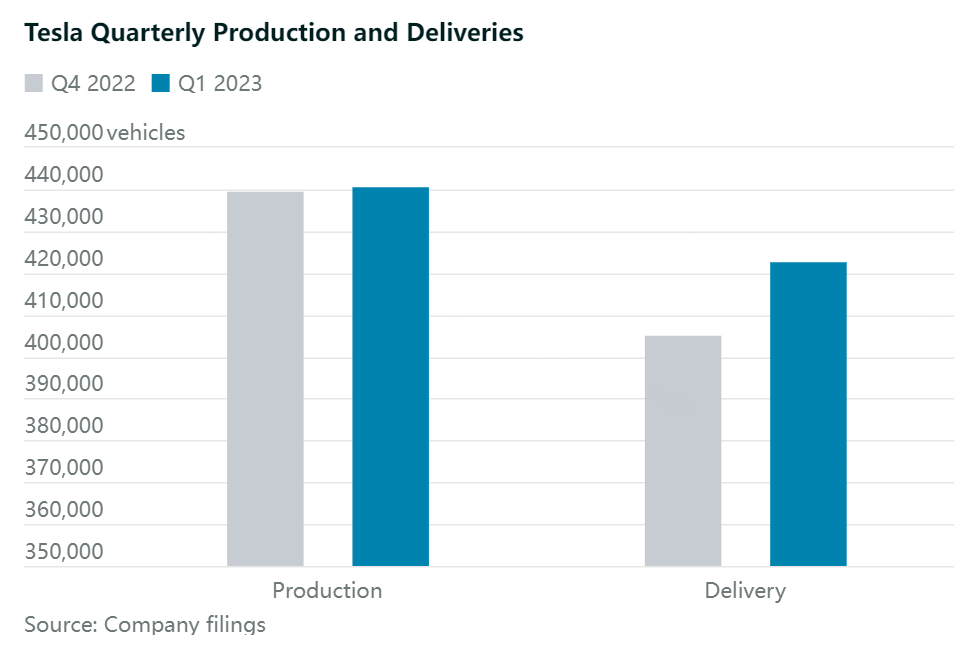Tesla posted record quarterly delivery results Sunday. It should be good enough to keep the stock stable in Monday trading. At least, that’s what Tesla bulls hope.
Tesla (ticker: TSLA) delivered 422,875 vehicles in the first quarter. The company produced 440,808 units.
Both numbers are quarterly records for the electric vehicle maker. Tesla delivered 405,278 in the fourth quarter of 2022 and produced 439,701 units. Those were the previous quarterly records.
Wall Street was looking for about 420,000 units delivered over the first three months of 2023.
The production and sales numbers were both a little better than people expected, which should be a positive for Tesla shares Monday. Exactly how investors react to any data point, however, is hard to predict.
Tesla needed a strong result given how shares have been trading. Tesla stock finished the first quarter up more than 68%—the best first-quarter performance ever. In second place: 2012’s first quarter, when shares gained 30.4%. This year’s first quarter is the sixth best quarter for shares ever. The stock has been trading for 51 quarters.
A strong stock always raises the stakes for any company’s results.
The consensus is an average of dozens of estimates. There is no rhyme or reason to which analysts predict which results. A Tesla bear, GLJ research analyst Gordon Johnson, expected a beat. He modeled about 425,000 deliveries. Johnson rates shares Sell and has a $24.33 price target for the stock.
Deutsche Bank analyst Emmanuel Rosner is a Tesla bull, rating shares Buy. His price target is $250 a share. Rosner expected a miss. He modeled 416,000 units, “reflecting still the uncertain macro environment after the price cuts, as well as competitive pricing responses in China.”
Tesla didn’t quite get to Johnson’s 425,000 figure, but it is still qualifies as a “beat.” Tesla stock typically trades well between the period when quarterly deliveries are released and when the company reports quarterly results a few weeks later after a beat.
That is only a rule of thumb. Anything can happen. Tesla stock traded up 30% between the end of 2022 to just before Q4 results were reported in late January. That strong performance came despite fourth quarter deliveries of about 405,000 units, which missed the analyst consensus by about 15,000 units.
Another first quarter figure investors were watching for was the difference between production and deliveries. Tesla made 439,701 vehicles in the fourth quarter, 34,423 more than the 405,278 vehicles shipped. Tesla grew sales faster than production in the first quarter: The difference between production and deliveries came in at 17,933 units.
The Q1 production/delivery spread is a positive result. Investors don’t want to see the spread between production and deliveries grow as a percentage of total deliveries. A growing difference can signal a demand issue and, if left unchecked, lead to a production slowdown.
For the stock, Rosner and Johnson are just one bull and one bear. Tesla has more than 40 analysts covering the stock. Overall, about 53% of analysts covering Tesla rate shares Buy. The average Buy-rating ratio for stocks in the S&P 500 is about 58%. Analysts have been using the strong start to the year to take some profits in Tesla stock. At the start of 2023, about 64% of analysts covering the company rated shares Buy.
The average analyst price target sits at about $204, which values Tesla stock at almost $700 billion, including stock options held by management.
In Friday trading, the stock rose 6.2% on moves about California and EV tax credits. California wants half of 50% of heavy-duty truck sales to be electric by 2035 and updated rules for EV tax credits from the IRS that were better than investors feared.
The S&P 500 was up 1.4%. The Nasdaq Composite was up 1.7%.
Editor's Note: There are some compilations of analyst estimates other than the one here that indicated quarterly deliveries were below expectations.


